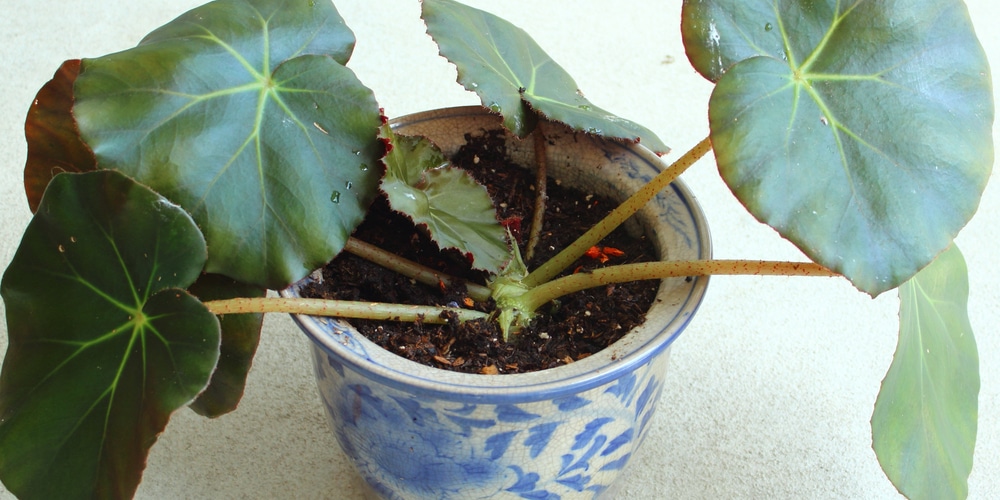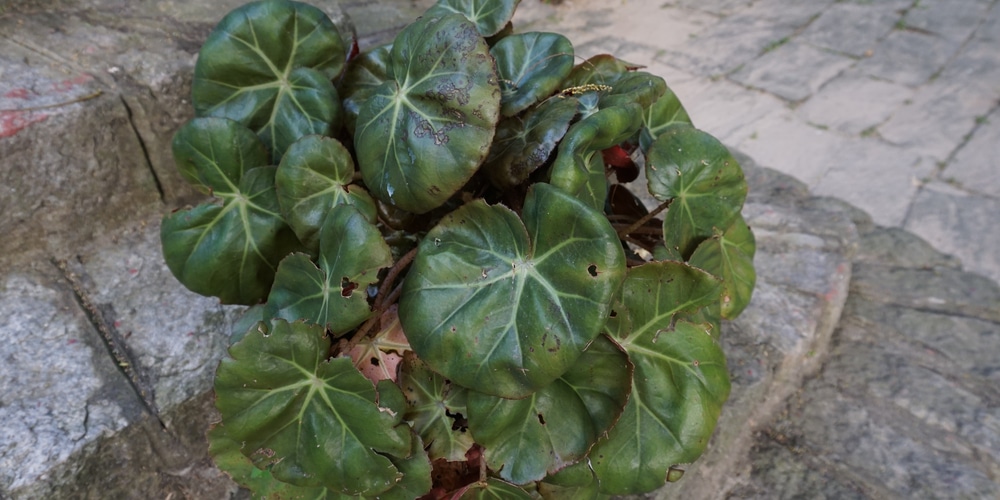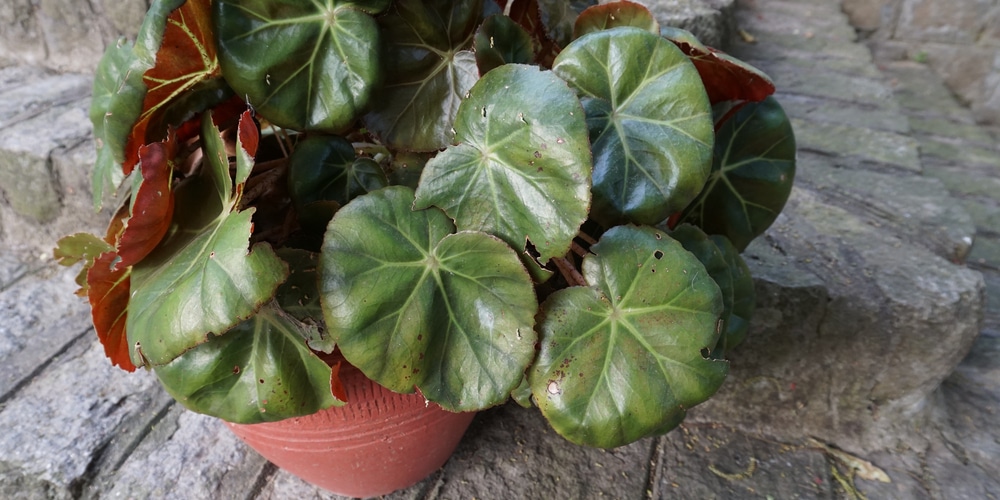Beefsteak Begonia (Begonia Erythrophylla) is a cross between a Begonia manicata and a B. hydrocotylifolia. Plant breeders created this hybrid in 1845, Germany.
This cultivar is a rhizomatous begonia, which means its stems can produce new growth—so you do not need a node when taking clones. All in all, it seems to have the growth needs of a succulent plant. But it is a perennial from the Begoniaceae family.
Like a low-maintenance succulent, this begonia does not need as much light and water. It is a classic houseplant for new plant parents and the ideal begonia for new collectors.
Begonia Erythrophylla: Quick Facts
- Botanical Name: Begonia Erythrophylla
- Common Names: Beefsteak Begonia, Pond lily
- Plant Type: Perennial
- Flower Color: Pink lace, Soft pink, pink and white
- Size When Mature: 24 inches (height), 36 inches (width)
- Bloom Time: Spring
- Sun Requirements: Shade to partial shade
- USDA Hardiness Zones: 10-11
- Soil PH Range: 5-6
- Soil Type: Moist, humus-rich, and well-draining
- Water Needs: Medium
- Native Area: Germany, tropics
What you Need to Know About Begonia Erythrophylla
The green leaves need at least part shade or shade location to grow. The bronze leaves, the darker red ones, can take the morning sunshine. Under the leaves, you will find a hairy central stem from which the plant will send out new shoots.
When you flip the shiny green leaves, you will see a bright red underside. The contrast between the two colors becomes even more gorgeous with the light coming in through the window.
This houseplant is poisonous for children, dogs, cats, and even horses. So, it is better to find a safe spot. If everything goes according to plan, you will enjoy its showy pink and white flowers. Most begonias flower during summer or fall. But this cultivar usually blooms in spring.
Outdoors, this begonia would dry out and die during the summer, after it produces seeds. But when growing indoors, it can survive and thrive like a perennial.
How to Care for Beefsteak Begonia
Here’s everything you need to know about growing and caring for a thriving Begonia Erythrophylla
Light
A Beefsteak Begonia should receive more than six hours of bright indirect sunlight. Usually, it can handle a couple of hours of the morning sun. But you had better keep it in shade or partial shade to avoid sunburns.
This cultivar does well with minimal light. In other words, you can put it anywhere you like. But as a result, it will develop dark green leaves.
To prevent the leaves from leaning towards the light, rotate the Begonia Erythrophylla once a week. This plant can grow on one side of the pot pretty fast. So, rotating it will also prevent accidental tipping.
Water and Soil Needs
Begonias do not need much soil in their potting mix. Above all, they like a well-draining, humus-rich medium. But they can adapt to a standard moist soil mixture as well.
To avoid root rot and enhance drainage, place coarse sand or mix clay pebbles with soil at the bottom of the pot. You can use a slightly acidic organic soil mix (pH 5-6) as substrate.
Begonia Erythrophylla deals with being underwatered pretty well. But for the best results, the soil medium should always be moist.
Watering this plant once a week is enough. In any case, touch the soil and make sure it is damp and not soggy before watering it again.
Temperature Requirements
The temperature must never drop below 39F. Because the Beefsteak Begonia is a hybrid of two tropical Begonias, this plant only survives outdoors in USDA zones 10 and 11.
Humidity-wise, the growing room should not be dry (<45%). The humidity level will take care of itself if you keep your Begonia Erythrophylla at a temperature between 64 and 80 F.
If you buy this plant from a greenhouse, it could have a hard time acclimating to lower humidity levels. In that case, consider running a humidifier and slowly decrease the humidity every week.
Fertilizer
The Beefsteak Begonia’s fragile root system prefers liquid fertilizers. If you give your begonia humus-rich soil, you will not need to fertilize your plant more than once a month. More importantly, heavily dilute any all-purpose fertilizers and test how your plant responds.
This plant does not have specific needs because it grows like a weed. So, using a slow-release fertilizer stick is also a good idea.
Common Diseases
Sadly, begonias can suffer from several diseases. The most common problem with Beefsteak Begonia is powdery mildew, a fungal infection. That is, a fuzzy, whitish-gray foam on the leaves.
The wind can take the spores that cause the powdery mildew for miles. Once the spores germinate, the fungus spreads rapidly. For clarity, this issue happens because of high humidity levels and poor ventilation. If you spot any signs of powdery mildew or other fungal infections, quarantine the plant immediately to prevent contamination.
Using a broad-spectrum fungicide usually solves the powdery mildew issue. But you can also cut the affected leaves, promoting new growth.
Beefsteak Begonia Propagation
You can propagate this plant through leaf cutting. In essence, you take a leaf and cut it into different parts. Press the leaf parts into damp soil mix inside a container. Then, put the lid on it. The leaf will regenerate the whole plant.
If you choose this option, remember to open the container every two days to change the air.
As mentioned above, you can cut any stem and put it into water. In a few weeks, the cutting will produce new roots. But you can also cut the stem off and leave a short stump where it attaches to the underside.
Once the roots emerge, you can stick the Beefsteak Begonia cutting into the new potting mix. Do not bury it more than two inches, though. If you leave a long stem, use support to keep the leaf up until it firmly roots into the new location.
Keep the clones under a grow light or near a window—but away from direct sunlight.
How to Prune Begonia Erythrophylla
You can prune the Beefsteak Begonia to achieve different aesthetics. In the end, you can shape how your Begonia Erythrophylla looks anytime. But the most suitable time for pruning is March-April.
Trim the apical part of the new, long, and thin branches to promote lateral growth and more showy flowers. The only tool you need is a sharp pruning tool. Of course, apply Isopropyl Alcohol to sterilize your scissors or pruning shears, too.


